Best dehumidifiers for banishing damp and drying laundry fast — tried and tested by the Ideal Home team
Alongside a team of experts, I've tried and tested the best dehumidifiers from Meaco, Pro Breeze, De'Longhi, and more
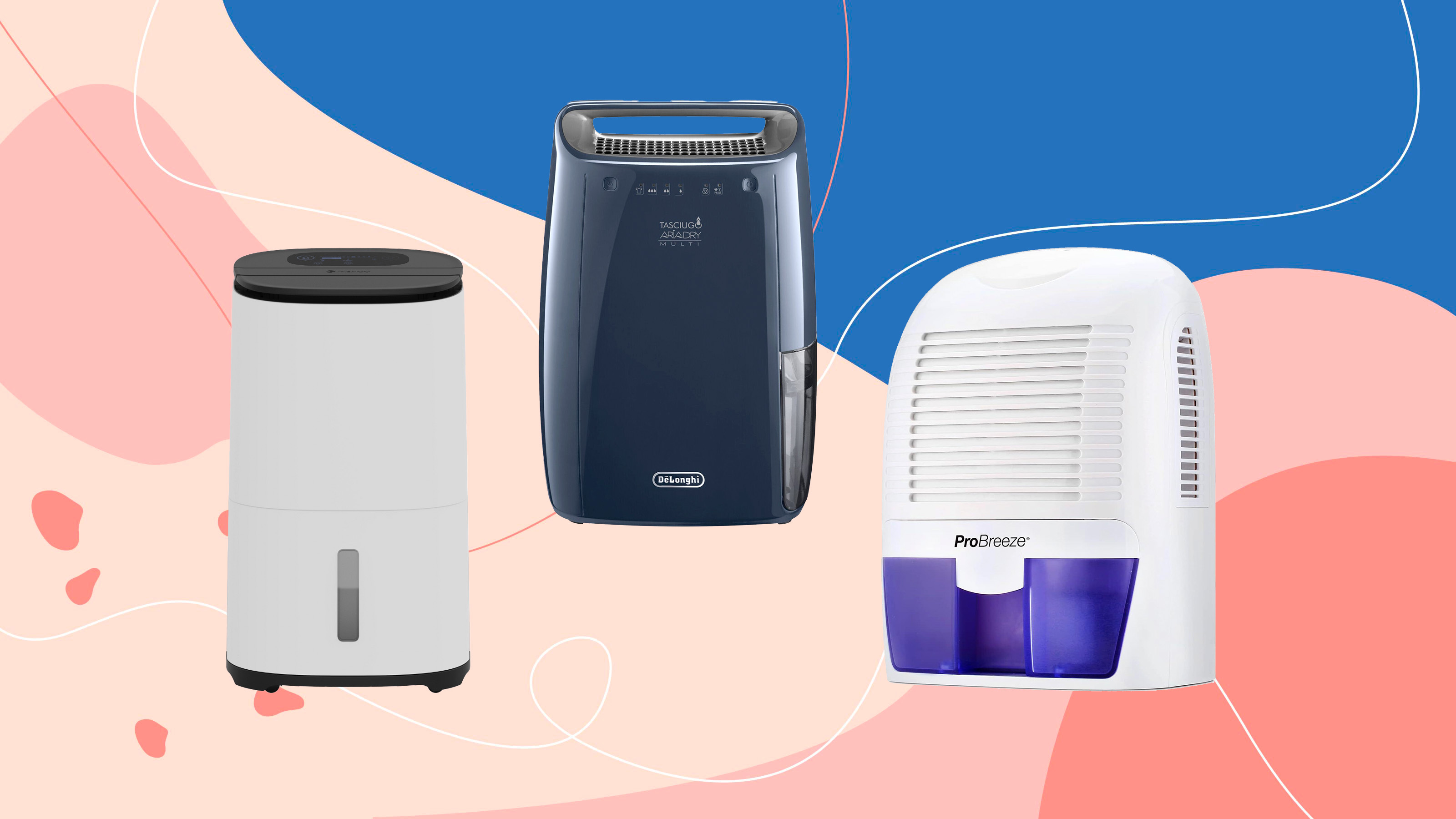

Utilising one of the best dehumidifiers can offer a simple and reliable solution to the build-up of damp, mould, and condensation in your home - and it can even speed up the drying process of wet clothes. That’s because these handy contraptions extract excess moisture from the air to maintain the ideal humidity level you need to live comfortably in your house.
However, just as buying one of the best air purifiers can leave you scratching your head, buying a dehumidifier can also be a minefield. You might spend days or even weeks trying to decode exactly what extraction rates, desiccant vs compressor, tank capacity, and laundry modes really mean and how they suit your needs and requirements. And as someone who likes to get as much bang for my buck, I'd hate for you to spend your money on a dehumidifier that doesn't quite work for your home.
That's why I and a team of certified experts have spent months following Ideal Home's dehumidifier testing process, testing some of the bestselling dehumidifiers on the market and lesser-known products, all offering a solution to excess moisture. We’ve evaluated everything you need to know about them, from how well they tackle damp to how much they cost to run and what size homes they'd suit. With this information at hand, I’ve been able to narrow them down to my top 6 best dehumidifier picks.
The quick list
Short on time? This quick list is an overview of the very best dehumidifiers we've tested. You'll find more information on each dehumidifier and why our testers recommend it if you keep on scrolling.

Best dehumidifier overall
The best dehumidifier we've tested, the MeacoDry Arete Two is quiet, easy to use, works superbly and is very energy-efficient compared to other compressor dehumidifiers. The Arete Two is an impressive step-up from its predecessor, now complete with a timer, Wi-Fi connectivity and Smart capabilities which the Arete One previously lacked. Plus, its Smart Laundry Mode is brilliant at drying wet washing. It's also available in multiple sizes and offers built-in HEPA air purifiers.

Best affordable dehumidifier
Whilst it can't quite beat the MeacoDry Arete Two on energy efficiency, and lacks the HEPA air filter, the ElectriQ 12L Dehumidifier is a great budget buy. It's quiet, portable, has a built-in carbon filter to remove odours as well as moisture, and its colour-changing indicator light is a brilliant feature for viewing your home's humidity levels at a glance. And, despite its lack of dedicated Laundry Drying mode, our tests still found it made short work of drying wet washing.

Best desiccant dehumidifier
A desiccant dehumidifier differs from a compressor or Peltier dehumidifier in that it's more efficient at lower temperatures. The EcoAir DD1 Simple MK3 can be operated in any space that's above 1°C, making it a great option for a garage, basement, or unheated rooms during the winter months. In our tests, it also performed brilliantly in normal conditions, making quick work of drying wet washing. The only downside is its price and higher running costs.

Best dehumidifier for drying clothes
Super sleek, with a built-in carry handle, this Italian-designed dehumidifier is big on style. It delivers on performance too, with a powerful extraction rate and dedicated Laundry mode that can dry wet washing fast. It's also relatively quiet and very easy to use. Overall, there's a lot to love, except, perhaps, the Tascuigo's price tag.

High capacity dehumidifier
This dehumidifier can extract up to 30L of moisture from the air per day, giving it one of the highest extraction rates on the market. That makes it a good choice if you have high moisture levels to deal with, plus its decent-sized 4L water tank means you won't be emptying it continually. Wi-Fi connectivity and voice-activated control are a great addition.

Best dehumidifier under £100
Small, affordable, super quiet, and with low running costs of just 1p per hour, this is a budget-friendly option for minor moisture problems. Its Peltier condenser has a much lower extraction rate than most compressor dehumidifiers, so don't expect powerful performance, but its compact build means it can be tucked easily away on a shelf, bedside table, or window sill to help reduce condensation.
Best dehumidifiers – tried and tested
Best dehumidifier overall





Specifications
Reasons to buy
Reasons to avoid
Having put multiple models through their paces to compile this guide, the new MeacoDry Arete Two Dehumidifier has now officially been crowned our top recommendation for best dehumidifier overall – taking the spot that its predecessor, the MeacoDry Arete One, previously held.
The Arete Two is almost identical to the Arete One in build quality, with the biggest aesthetic differences being that the Arete Two now has a premium LCD 'chase' display, offering you more control than ever, and a louvre which allows you to direct the necessary flow of air to the area in need of treatment. It's is easy to use, whisper quiet, works superbly, and is very energy-efficient compared to pretty much every other compressor dehumidifier on the market. Plus, as well as first-rate moisture extraction, it's equipped with a built-in HEPA air filter that rivals many dedicated air purifiers to improve indoor air quality in more ways than one.
The automatic Smart Humidity mode makes for hassle-free operation, turning the dehumidifier on when moisture levels rise and automatically shutting the appliance off when the target humidity level is reached. In our tests, the Arete Two reduced moisture levels in damp-prone rooms in a very short period of time and collected a shocking amount of water over just a 1-2 day span. The dedicated Smart Laundry drying mode also works brilliantly – wet washing was dry in hours rather than the days it can usually take in the terraced home it was tested in.
One of the gripes we had about the MeacoDry Arete One was the fact that it lacked a timer and Smart capabilities. However, the Arete Two has quickly solved those issues as it can now be controlled through the new Meaco smartphone app as well as hooked up to any voice control assistants you have set up in your home, such as Alexa or Google. Plus, the timer can be set between 1-24 hours.
Although the one we tested was the 20L capacity, there are four different sized dehumidifiers in the Arete Two range, offering moisture extraction rates of 10, 12, 20 or 25 litres per day. That means it's easy to find the right option for your home size, and the level of moisture control you need. All come with generous water tank capacity that means you aren't constantly emptying them, and their energy-efficiency is best-in-class with power usage of just 136W for the smallest 10L model and a mere 250W for the biggest 25L model which means running costs stay low.
Overall, this is a best-in-class dehumidifier that does a fantastic job of extracting moisture from the home and remains hard to beat by any of its competition – and the new quality of life updates the Arete got in its 2nd generation have easily made it all the better.
Read our MeacoDry Arete Two Dehumidifier review for more detail.
Best affordable dehumidifier

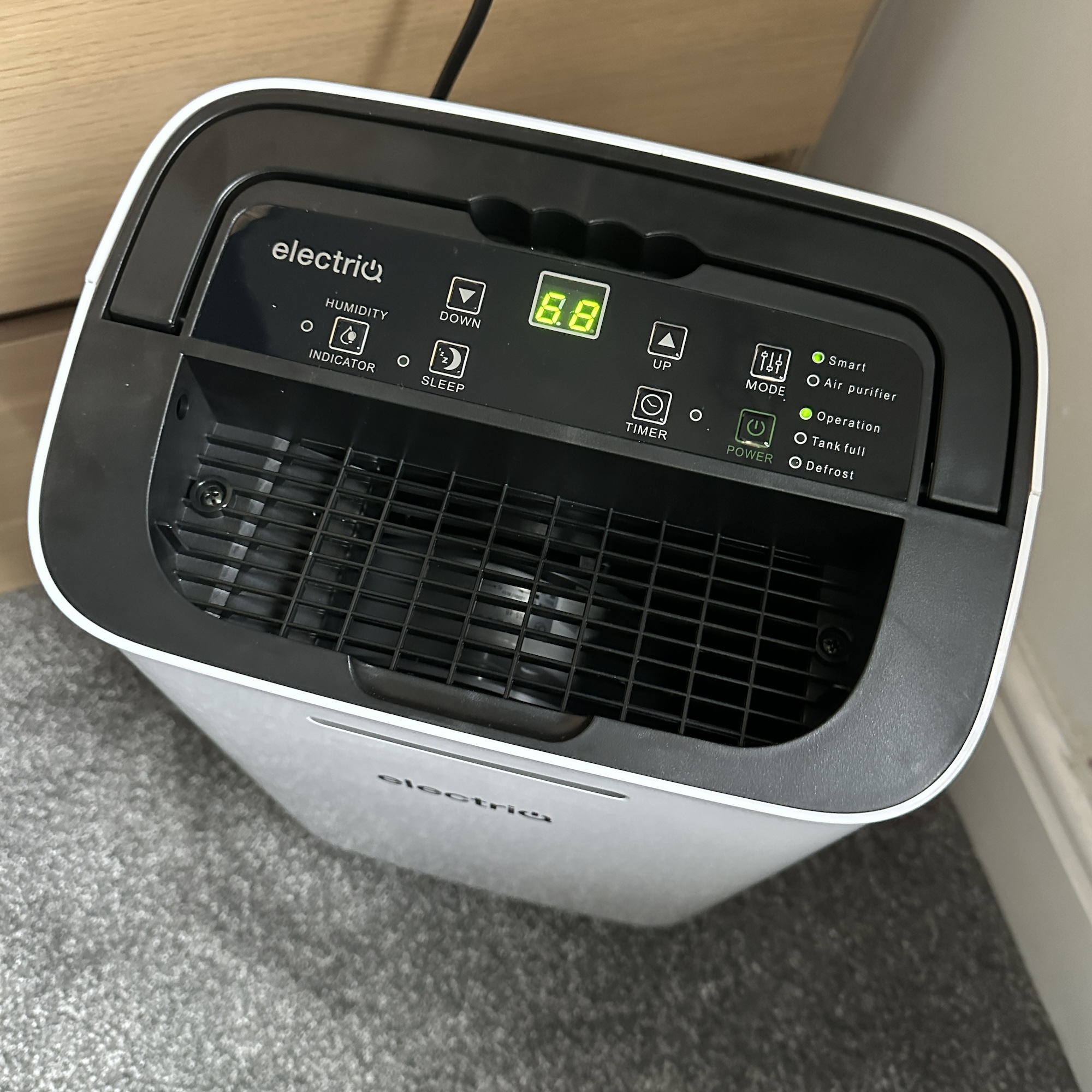



Specifications
Reasons to buy
Reasons to avoid
The ElectriQ 12L Dehumidifier is one of the best budget dehumidifiers we've tested. Decent dehumidifiers don't come cheap, and it's rare to find a compressor dehumidifier – which is the type you want if you have significant damp issues – that offers this level of performance for under £150.
It can't quite compete with our top recommendation, the MeacoDry Arete Two Dehumidifier, which is more energy-efficient, offers a built-in HEPA air filter as standard, and is slightly quieter to run. But it comes close, and offers a lighter build and more budget-friendly price tag. Our reviewer thought it was a great choice for anyone who wants a small, compact dehumidifier that's good value for money.
It can extract 12L of moisture from the air per day, and in our tests it worked hard to do so, filling its 2.5L water tank with condensed water in just a few hours. It features an automatic humidity sensor so you can set your target humidity levels and allow it to do its thing, and also offers an easy-to-read humidity indicator light that glows green when humidity is in the target range and amber or red when humidity is high – a great way to see your home's damp levels at a glance.
Whilst it doesn't have a dedicated Laundry Drying mode like the MeacoDry Arete Two, De'Longhi Tascuigo AriaDry Multi Dehumidifier or Pro Breeze 20L Premium Dehumidifier with Special Laundry Mode, our tester found she didn't need it. She simply set the target humidity to 35% and the ElectriQ 12L made short work of speeding up indoor drying times in her laundry room. It also features a built-in carbon filter that our reviewer found reduced odours from cooking fumes and pets.
The ElectriQ doesn't offer Wi-Fi connectivity like the Duux Bora Smart 20L Dehumidifier or Pro Breeze 30L Premium Dehumidifier, and the water tank was a little fiddly to empty. But, overall, as long as you only need a 12L extraction rate, this is a great dehumidifier for the price.
Read our full ElectriQ 12L Dehumidifier review for more detail.
Best desiccant dehumidifier


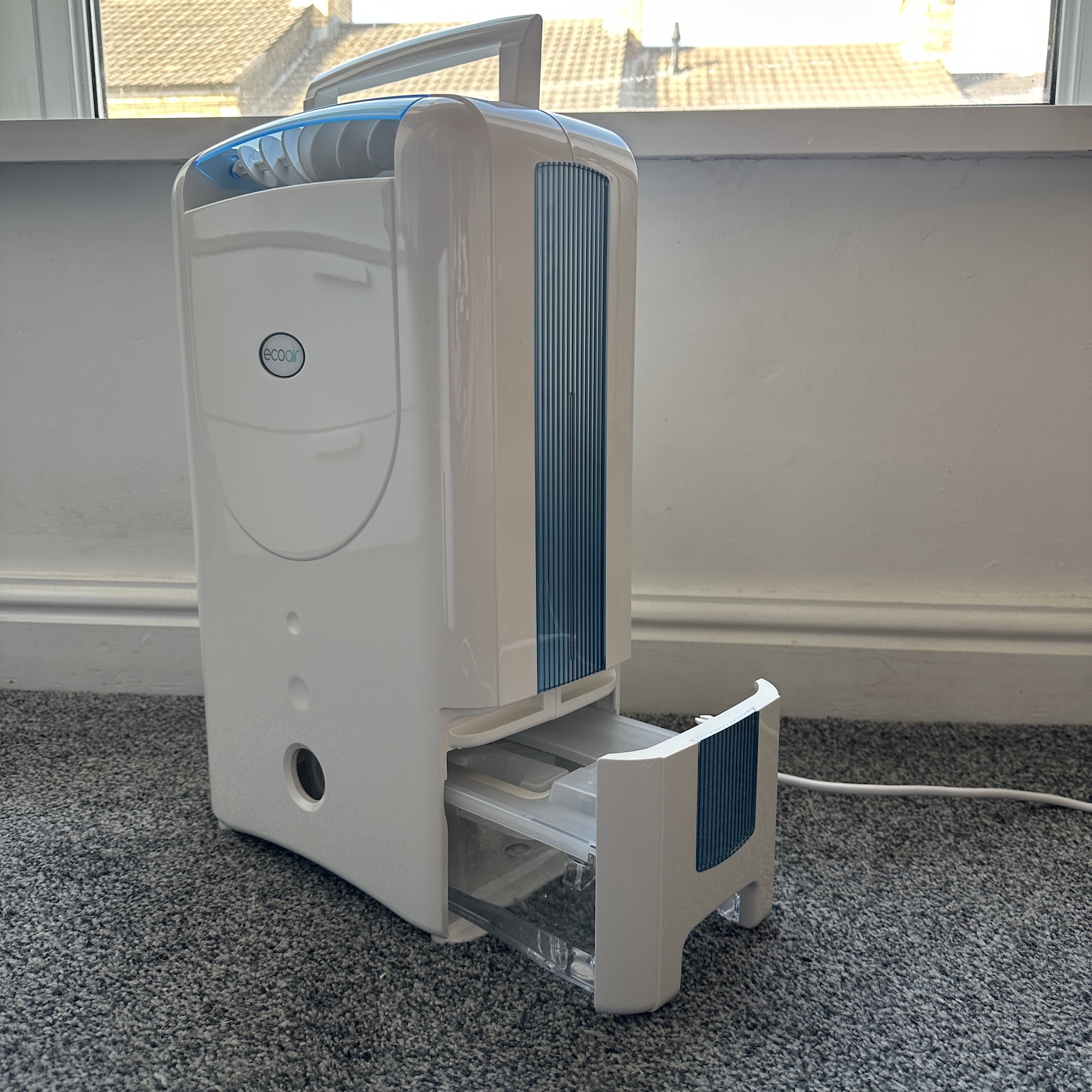


Specifications
Reasons to buy
Reasons to avoid
Unlike a compressor dehumidifier that passes air over a cold coil to condense the water from it, a desiccant dehumidifier uses a 'desiccant chemical' to absorb the moisture from the air. As a result, desiccant dehumidifiers are the best option for rooms that are likely to fall below 5°c, as at lower temperatures compressor and Peltier models can struggle to work efficiently.
The EcoAir DD1 Simple MK3 Dehumidifier can extract up to 7.5 litres of moisture per day in cold temperatures as low as 1ºc, so it's a very useful option for conservatories, basements or garages that don't have dedicated heating, as well as unheated rooms in the home during winter months.
That said, in our tests it also worked brilliantly during normal use, quickly reducing humidity and making fast work of drying wet washing. This is helped by the warm air the Simple MK3 kicks out whilst running. EcoAir says that in general 'desiccant dehumidifiers emit warmer air (approx. 3-5 degrees Celsius warmer than the ambient air) than compressor models' which can make a desiccant dehumidifier a particularly good choice for drying wet laundry indoors.
As its name would suggest, the Simple MK3 is also very simple to set up and operate with easy-to-use manual controls. For its price, we just found it lacked the design quality of models like the De'Longhi Tascuigo AriaDry Multi Dehumidifier and couldn't compete with the better energy efficiency and extra functionality of the MeacoDry Arete Two Dehumidifier – the Arete Two's Smart Humidity mode is particularly useful for controlling humidity without any user input and saves on energy use and running costs.
In fact, along with the higher price ticket, running costs are one of the biggest cons with this product. The 7.5L DD1 Simple MK3 uses 300-580W of electricity compared to the 10L MeacoDry Arete Two's 136W, which means the EcoAir model costs between 9p and 17p per hour to run at current energy prices, compared to the Meaco Arete's average of 3p per hour. However, if you're looking for a dehumidifier for use in a cold climate, the EcoAir DD1 Simple MK3 Dehumidifier's 1ºc operating temperature is hard to beat. Alternatively, if you want a desiccant option with a more affordable initial upfront cost, it might also be worth checking out the VonHaus Desiccant Dehumidifier as it shares many similar functionalities.
Read our full EcoAir DD1 Simple MK3 Dehumidifier review for more detail.
Best dehumidifier for drying clothes




Specifications
Reasons to buy
Reasons to avoid
Overall, the De’Longhi Tasciugo AriaDry is a great dehumidifier. It’s sleek, stylish and, most importantly, it works really well.
As well as rapidly extracting moisture from damp-prone rooms, it does an amazing job of drying laundry; on par with the MeacoDry Arete Two Dehumidifier. The simple interface also means it's easy to use, without any complicated settings to get your head around, and, although it doesn't have wheels, its ergonomic carry handle makes it easy to move around the home.
Beyond that, it's relatively quiet when running, has a built-in air filter for air purification on top of its damp-defying powers, and, its energy usage is relatively low.
Really, the Tasciugo only has a few downsides. Although the AriaDry has an automatic humidity sensor so it will switch itself off once your desired setting is reached, it doesn't have a humidity display, so you can't tell what a room's current humidity levels are – something we missed considering its price point. The water tank could also be a lot larger. Its powerful performance meant we were emptying the 2.1L tank very frequently during testing, although there is a continuous drainage option and hose supplied.
It's also not quite the most energy-efficient model on the market. That accolade goes to the our top recommendation, the MeacoDry Arete Two Dehumidifier. The comparable 12L Meaco Arete Two costs just 3p an hour to run compared to the 12L De’Longhi Tasciugo AriaDry's average 8p per hour, matches the Tascuigo on specfications, and offers a humidity display.
And, lastly, there's the De’Longhi Tasciugo AriaDry dehumidifier's price. The stylish Italian design comes at a cost, with this one of the most expensive dehumidifiers on the market.
Read our full De’Longhi Tasciugo AriaDry Multi Dehumidifier review for more detail.
High capacity dehumidifier


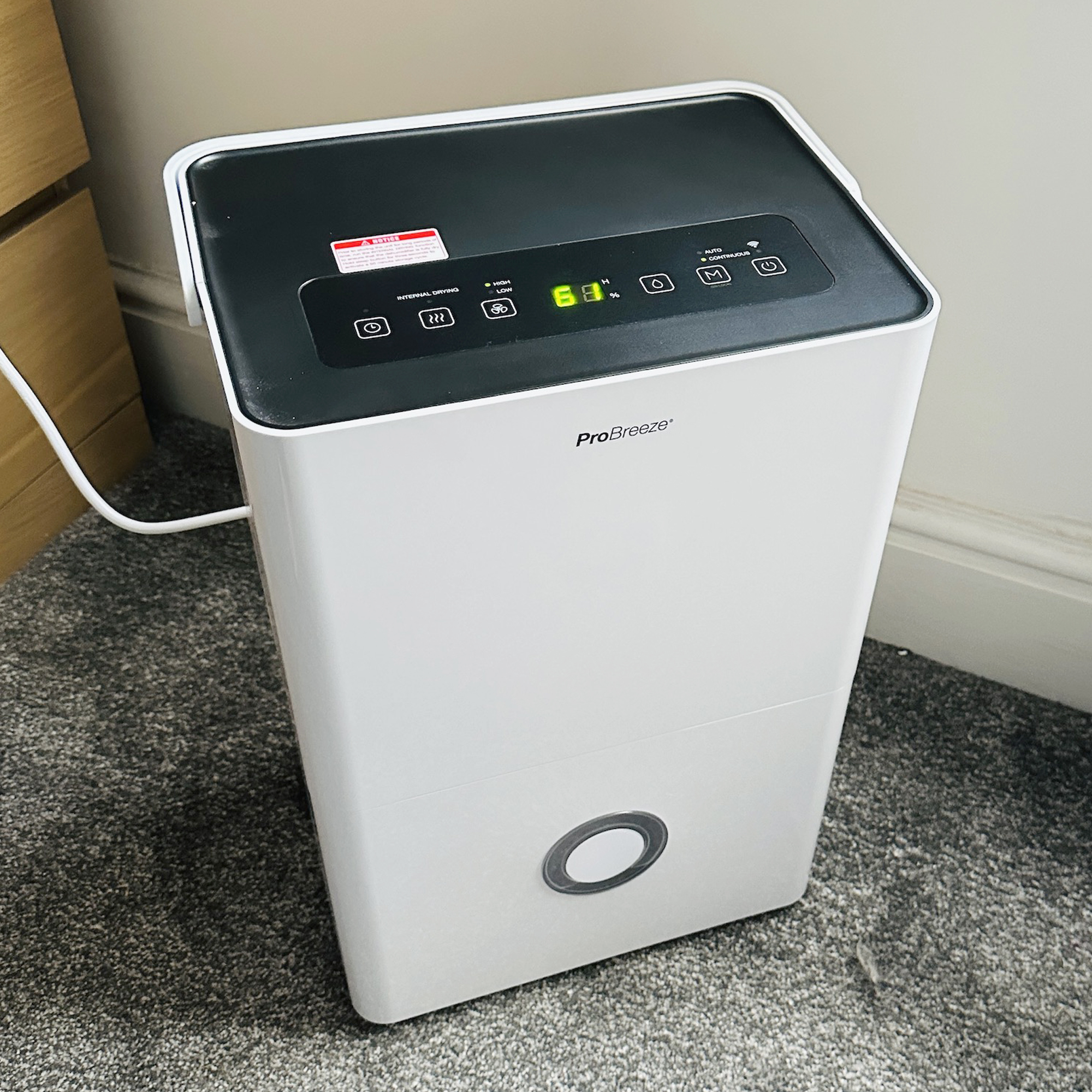



Specifications
Reasons to buy
Reasons to avoid
The Pro Breeze High Capacity Smart Dehumidifier is a high-capacity dehumidifier that can extract up to 30L of moisture from the air per day, giving it one of the highest extraction rates on the market.
It also offers Smart App controls, which means you can connect it to Wi-Fi and operate it remotely via the Pro Breeze App or connect to Alexa or similar voice-activated devices. It has a decent-sized water tank capacity of 4L, and an automatic humidity sensor which means you can set your desired humidity level, switch it on, and just let it do its thing.
During our testing process, we found it really easy to use and operate, and our reviewer loved the Smart App connectivity as it gave her a lot more control over how she could use the machine, saying the in-app experience is fantastic, the menus are really clear, and changing the settings is simple'. Alongside the Duux Bora Smart 20L Dehumidifier, this is one of only a handful of dehumidifiers on the market that currently offer remote and voice-activated control.
Whilst this dehumidifier doesn't offer a specific laundry drying function, we still found it helpful at drying wet washing, although it took longer to do so than dehumidifiers with a dedicated Laundry mode, like the De'Longhi Tascuigo AriaDry Multi Dehumidifier and Pro Breeze 20L Premium Dehumidifier with Special Laundry Mode.
However, the 30L Premium Dehumidifier isn't without faults. Its 600W power usage is considerable compared to the only slightly lower extraction rate of the 25L MeacoDry Arete Two Dehumidifier which only uses 250W of energy. The Pro Breeze 30L Premium Dehumidifier operates at 46dB, and unfortunately, it's loud whether the fans are in high or low mode. This isn't a dehumidifier for the bedroom or one you're going to want running for long periods in a living area that's in use.
That said, the Pro Breeze 30L Premium Dehumidifier's high 30L per day extraction rate makes it a great choice if you have high moisture levels to deal with, and its decent-sized 4L water tank means you won't be emptying it continually. Its Wi-Fi connectivity will also be a real bonus for many users.
Read our full Pro Breeze 30L High Capacity Smart Dehumidifier review for more detail.
Best dehumidifier under £100

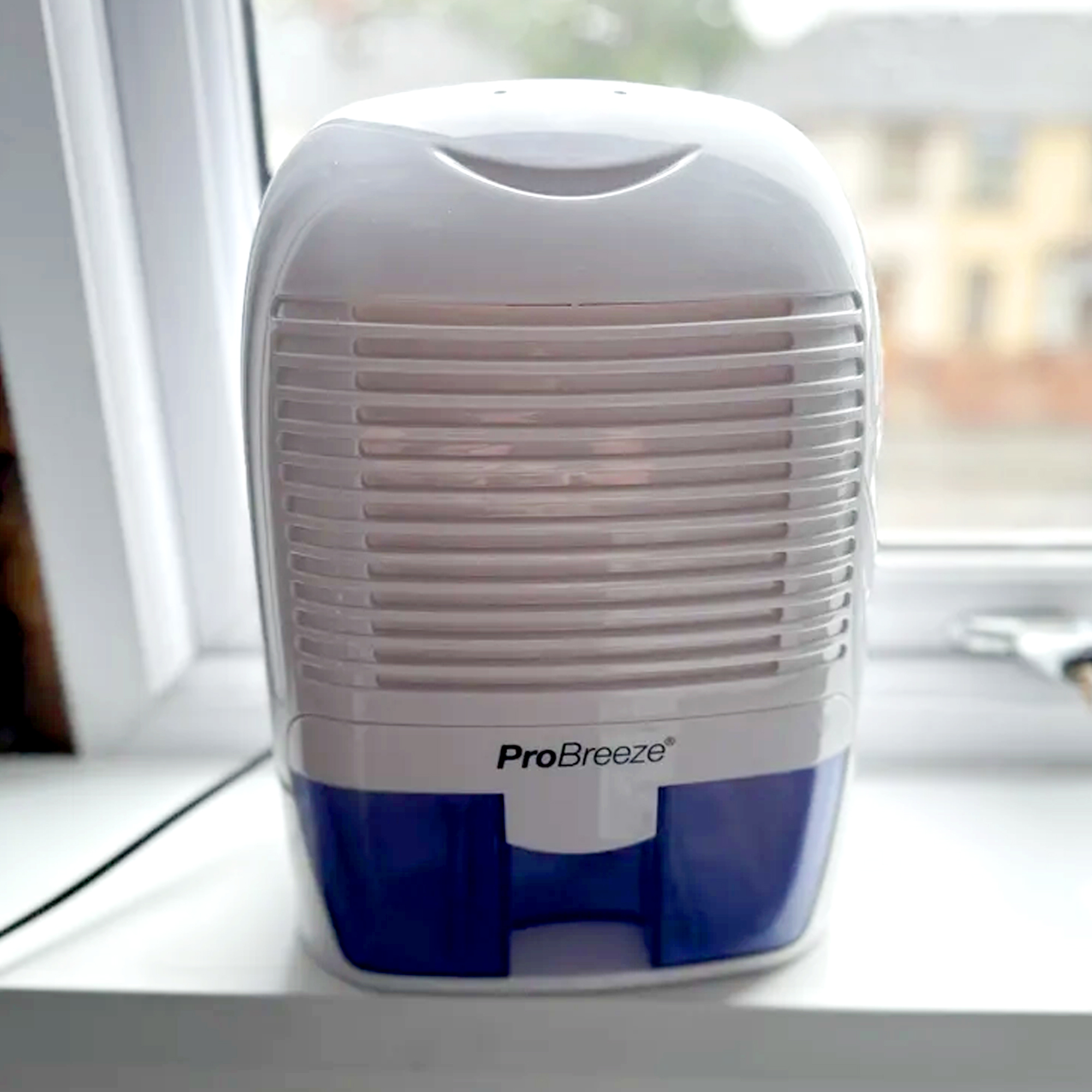


Specifications
Reasons to buy
Reasons to avoid
It's important to note that this small Peltier dehumidifier has a very low extraction rate compared to every other dehumidifier in this round-up. The Pro Breeze 1500ml Mini Dehumidifier can extract just 0.5L of moisture from the air per day, far below most compressor dehumidifiers which tend to have extraction rates that start at 10L or 12L per day.
Peltier operation also means this dehumidifier can only be used in rooms with an ambient temperature of 15-35°C, unlike most compressor dehumidifiers which operate above 5°C, or the desiccant EcoAir DD1 Simple MK3 Dehumidifier which can operate at temperatures as low as 1°C.
As such, this dehumidifier is designed for managing fairly low moisture levels in small rooms up to 15m². It isn't going to able to control humidity within an entire house like larger capacity dehumidifiers, and it won't make a lot of difference to high moisture levels – we found it made little difference when drying wet washing for example. That said, as long as you don't expect too much of it, this mini dehumidifier still impressed us during testing, and its budget-friendly price tag is a definite bonus.
It lacks functionality, so this dehumidifier is either on or off. But, that does make it extremely easy to use, and our reviewer found it did a decent job of eliminating condensation on windows in a small bedroom when left running overnight.
Its compact design means it easily fits on a bedside table, shelf or window sill, and our tester also found it extremely quiet compared to most compressor dehumidifiers, so it's great for a bedroom. Plus, the Peltier design makes for low energy use, with the 40W dehumidifier costing just 1p per hour to run at current energy prices.
Those low running costs combined with a very affordable price tag, mean we think this is one of the best dehumidifiers under £100 – an ideal low-cost dehumidifier for any small room where you want to combat low levels of excess moisture without breaking the bank.
Read our full ProBreeze 1500ml Mini Dehumidifier review for more detail.
The runners-up
We aim to test new dehumidifiers every month, following the Ideal Home testing process to determine whether popular bestsellers or new releases can outperform the best dehumidifiers in this round-up. By doing this, we can keep this guide as up-to-date as possible, ensuring that we’re only recommending the best-in-class options on the market.
Not all the dehumidifiers we review make the grade and get included in this edit - perhaps they were replaced by a newer model or were more expensive than we'd hoped - but we've included some runners-up below to compare their pros and cons and make sure you’re choosing the right option for you and your needs.
- MeacoDry Arete One: The MeacoDry Arete One is an exceptional dehumidifier available in 10L, 12L, 20L, and 25L sizes. It also offers air purification to improve indoor air quality, and the only reason it's not in the main guide is because its successor - the Arete Two - just trumps it slightly.
- Pro Breeze 20L Premium Dehumidifier with Special Laundry Mode: If you want to dry your clothes indoors in winter, a dehumidifier like the Pro Breeze 20L Premium Dehumidifier with Special Laundry Mode will help you out. With a 20L per day extraction rate and dedicated laundry function, it's ideal for this task. It is a little noisier than other alternatives, though.
- VonHaus Desiccant Dehumidifier: The VonHaus Desiccant Dehumidifier thrives in colder rooms and can help dry out a damp room in no time. And while it doesn't boast any smart technology or a dedicated Laundry mode, it's extremely affordable and lightweight.
- Russell Hobbs RHDH2002 20L Dehumidifier: If you have a larger home, the Russell Hobbs RHDH2002 20L Dehumidifier is a powerful appliance that's capable of extracting up to 20L in rooms of up to 35-50m². It's also extremely easy to use. The higher energy use does mean higher running costs to consider, though.
- Duux Bora Smart 20L Dehumidifier: The Duux Bora Smart 20L Dehumidifier is one of the smartest dehumidifiers on the market. In fact, its Wi-Fi connectivity means it can be paired with voice-activated devices. Our only niggle is that it doesn't have a dedicated Laundry mode.
- Pro Breeze 12L Low Energy Dehumidifier: Although it's ideal for smaller spaces and those conscious of energy consumption, the Pro Breeze 12L Low Energy Dehumidifier still has a powerful extraction rate. It also has an automatic humidity sensor but isn't the best at drying washing.
| Dehumidifier | Price | Ideal Home Rating | Brand Trustpilot Score | Sizes Available | Type |
| MeacoDry Arete Two Dehumidifier / Air Purifier | From £179.99 | 5 | 4.2 | 10L, 12L, 20L, 25L | Compressor |
| ElectriQ Dehumidifier | From £79.97 | 4.5 | 4.2 | 10L, 12L, 20L, 25L, 40L | Compressor |
| EcoAir DD1 Simple MK3 Dehumidifier | From £209.98 | 4.5 | 4.8 | 7.5L | Desiccant |
| De’Longhi Tasciugo AriaDry Multi Dehumidifier | From £249.99 | 4.5 | 4.4 | 12L, 14L, 16L | Compressor |
| Pro Breeze High Capacity Smart Dehumidifier | From £239.99 | 4 | 3.8 | 30L | Compressor |
| Pro Breeze 1500ml Mini Dehumidifier | From £44.99 | 4 | 3.8 | 0.5L | Peltier |
| MeacoDry Arete One | From £159.99 | 4.5 | 4.2 | 10L, 12L, 20L, and 25L | Compressor |
| Pro Breeze 20L Premium Dehumidifier with Special Laundry Mode | From £189.99 | 4.5 | 3.8 | 20L | Compressor |
| VonHaus Desiccant Dehumidifier | From £174.99 | 4 | 4.3 | 7L | Desiccant |
| Russell Hobbs RHDH2002 20L Dehumidifier | From £189.00 | 4 | 4 | 20L | Compressor |
| Duux Bora Smart 20L Dehumidifier | From £299.99 | 4 | 4.1 | 20L, 30L | Compressor |
| Pro Breeze 12L Low Energy Dehumidifier | From £184.99 | 4 | 3.8 | 12L | Compressor |
How we test
At Ideal Home, we know how important it is to have hands-on experience with the products we recommend to you in our buying guides. In fact, we will never recommend anything that we haven’t tried and tested ourselves.
That's why, as part of our rigorous testing protocol, we've tested every dehumidifier in this guide for at least two weeks (and often even longer) before deciding whether it's worthy of a place on this list or doesn't quite make the grade. Our in-depth explanation of how we test dehumidifiers has the full details.
In this instance, our team of trusted reviewers tested a host of the bestselling dehumidifiers to compile this guide. We compared performance indicators such as moisture extraction rate, tank capacity, how often each model needed emptying, ease of use of controls, aesthetics, and, of course, the price point to find the best value dehumidifiers.
We have also considered the size and weight of each appliance to find the most portable options, plus each model's noise levels. Another important aspect of our reviewing process includes comparing these models to other dehumidifiers on the market, where possible. These may be different models from the same brand with different capacities or functions, or they could be models from a different brand with similar functionalities.








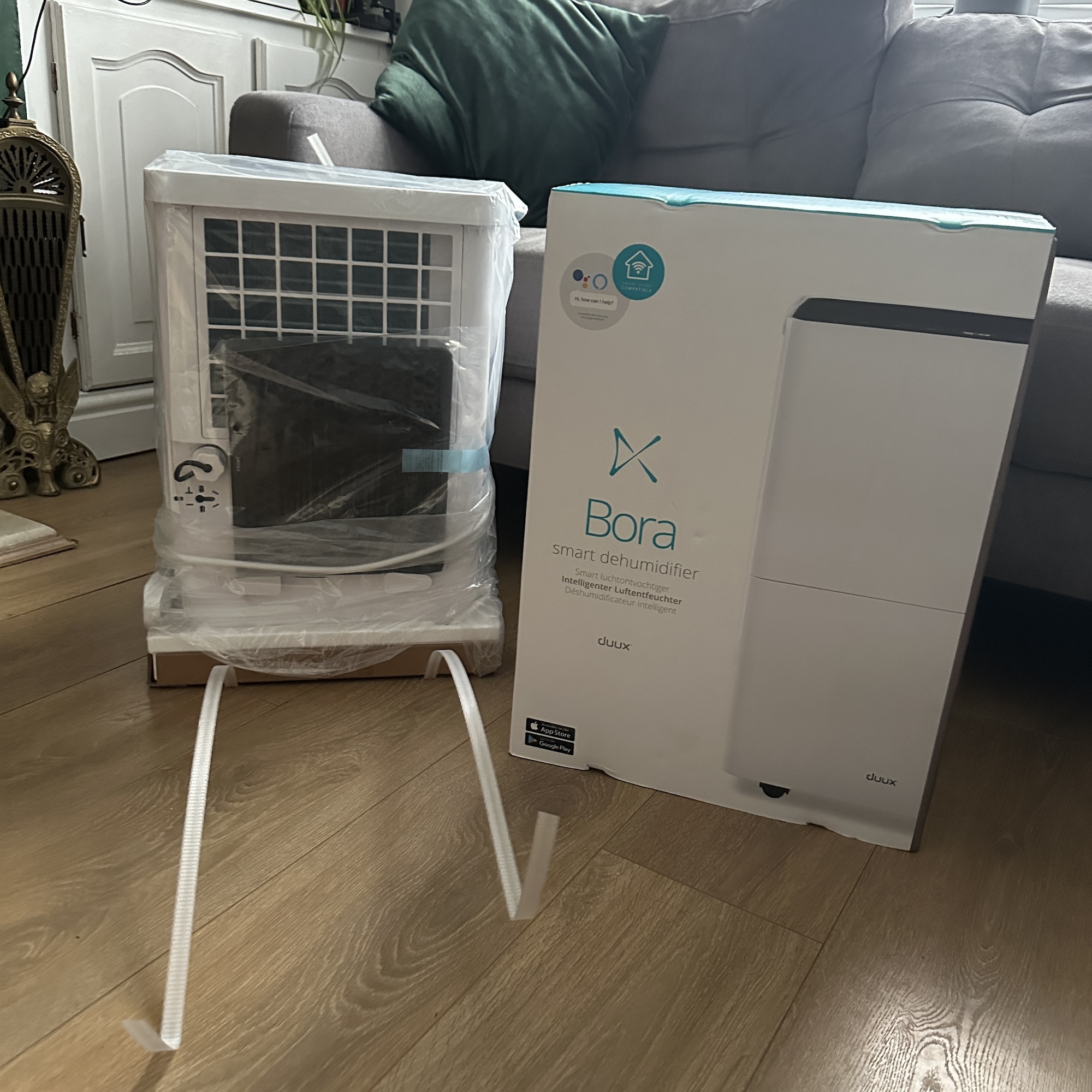


With all of this information at our disposal, we then assign the dehumidifiers a dedicated Ideal Home star rating. They are as follows:
5 stars - an impressive dehumidifier that does exactly what you expect and cannot be faulted in any way. It will also receive an Ideal Home-approved badge.
4.5 stars - a high-quality, hard-working dehumidifier, but it leaves us wishing for a bit more, so it loses that crucial half-mark. However, it will still receive an Ideal Home-approved badge.
4 stars - an impressive dehumidifier worth your money but may need some fine-tuning before it suits every customer and every home.
3 stars - a good dehumidifier that works well but doesn't blow us away with its specs or affordability. In some cases, it may also be difficult to use.
2 stars - an affordable dehumidifier that will suit the budget-conscious but is under-specced and lacks key features.
1 star - we would not recommend this dehumidifier, as it is underwhelming and does not work as well as it should.

Rachael is a freelance reviewer who helps the Ideal Home team put all manner of products through their paces to find the top recommendations for our readers.
She tested most of the dehumidifiers in this guide from her damp-prone Victorian terrace in Newport, South Wales - testing everything from their ability to tackle excess moisture to their laundry drying skills.

Jullia has tested a wide range of home appliances for the Ideal Home team - including vacuum cleaners, electric heaters, dehumidifiers and more.
She also had the pleasure of testing the impressive MeacoDry Arete Two in her home - allowing her hands-on experience with the best-in-class dehumidifiers.

Katie has been reviewing products for Ideal Home as a freelancer for the last two years.
She started out supporting the e-commerce team, researching the best products on the market across homes and gardens, and putting countless dehumidifiers through their paces. She tests and reviews new products in my flat in Leeds.
The best dehumidifier brands
As dehumidifiers rise in popularity, the sheer number of dehumidifiers on the market can make the buying process extremely overwhelming. So, I’ve compiled this quick list of dehumidifier brands that I’d recommend after years of testing. This includes budget-friendly brands known for producing all kinds of appliances to dehumidifier-specific brands that often have a slightly larger price tag.
- Meaco (£-££): Renowned manufacturer of dehumidifiers, including the Meaco Arete Two
- Pro Breeze (£-££): A wide selection of dehumidifiers to suit every price point
- Vonhaus (£-££): A small selection of affordable dehumidifiers with capacities of up to 20L
- Silentnight (£-££): Extremely affordable dehumidifiers often available at Amazon
- EcoAir (££-£££): Slightly pricier desiccant dehumidifiers in various sizes for different homes
- De'Longhi (££-£££): A small range of Italian-made dehumidifiers that are also incredibly stylish
- Duux (££-£££): High-quality, smart dehumidifiers at a higher price point
How to choose the best dehumidifier
Finding the best dehumidifier for your home depends a lot on the type of moisture issue you're trying to solve, so it's always worth speaking with the customer service department of the manufacturer you're hoping to buy from to ensure you have the right model for your needs. You can also check out our detailed guide on how to choose a dehumidifier for all of the information you could need.
However, to help give an overview, it's worth considering the following:
- The different types of dehumidifiers: Compressor, desiccant, and Peltier. Many experts agree that desiccant dehumidifiers are better.
- Extraction rate: The higher the extraction rate, the more powerful the machine will be. Knowing what size dehumidifier you need can help you choose the right option for you.
- Water tank capacity: How much water the water tank of the dehumidifier can hold before it needs emptying.
- Noise levels: Most dehumidifiers will fall between 35 and 45dB, but check the specs to be sure to ensure your dehumidifier continues to help you sleep better.
- Other features: Specific modes, smart functionality, auto sensors, etc.
When considering the above, it's also worth keeping a desired budget in mind so you don't end up spending more than you'd like to.
FAQs
Do I need a dehumidifier?
If you're wondering how to get rid of mould in a poorly ventilated room, or trying to combat excess moisture or humidity inside the home, then a dehumidifier can be a useful tool in your arsenal.
That's because excess moisture within the home can come from drying clothes indoors, cooking fumes from pans and kettles, bathing and showering, and the damp British weather. However, if your home doesn't have adequate ventilation, or it's winter and you don't want to open windows to avoid letting your heating escape, then a dehumidifier can help you to keep indoor moisture levels in check.
Does a dehumidifier use a lot of electricity?
You can find out more about how much electricity a dehumidifier will use in our guide to 'how much does it cost to run a dehumidifier?'
However, the easiest way to find out how much electricity an appliance uses is to look at its wattage. The higher the number of watts a dehumidifier requires, the more electricity it will use and the more expensive running costs will be.
Do dehumidifiers help to dry clothes?
Yes, a dehumidifier will help to dry clothes indoors. That's because a dehumidifier sucks up the moisture that wet washing releases as it dries, therefore helping to speed up drying times. In fact, when it comes to the heated airer vs dehumidifier debate, a dehumidifier with a good laundry drying function can give one of the best heated clothes airers a run for its money when it comes to drying wet washing, fast.
However, you do need to opt for a dehumidifier with a good extraction rate if you want to use it to dry washing. Our top choices are the MeacoDry Arete Two Dehumidifier range which offers models with a 10, 12, 20 or 25L extraction rate, the De'Longhi Tascuigo AriaDry Multi Dehumidifier, or the Pro Breeze Premium 20L Dehumidifier with Special Laundry Mode.
Is it worth buying an expensive dehumidifier?
Based upon our testing of a range of dehumidifiers of different price points, we would say yes, it is worth spending as much as you can on a dehumidifier.
That's because you ideally need a dehumidifier with a high extraction rate. The cheapest and smallest dehumidifiers on the market can often only extract 0.5L of water from the air per day – in many cases even less – but larger and more powerful dehumidifiers can extract up to 25L per day, which can make a huge difference to your home's health if you struggle with damp issues and condensation. The downside is that you will pay more the more powerful a dehumidifier is.
Get the Ideal Home Newsletter
Sign up to our newsletter for style and decor inspiration, house makeovers, project advice and more.

Amy is Ideal Home’s Sleep Editor and the Ideal Home Certified Expert on Sleep. She's spent the last four years researching and writing about what makes for the best night’s sleep during the day and testing out sleep products to find the best-in-class by night. So far she’s clocked up over 10,000 hours of pillow, duvet, and mattress testing experience.
Our go-to for all things sleep-related, she’s slept on and under bestselling products from Simba, Emma, Hypnos, Tempur, Silentnight, Panda, and many many more.
As a hot sleeper, Amy is always on the lookout for the most breathable bedding, but she also leads a wider team of testers to ensure our product testing encompasses both hot sleepers, cold sleepers, front sleepers, back sleepers, side sleepers, and everything in-between.
- Lauren BradburyContent Editor (House Manual)
- Jullia JosonJunior Writer
-
 Typhur Dome 2 air fryer review – a glimpse into the future of air frying
Typhur Dome 2 air fryer review – a glimpse into the future of air fryingThe Typhur Dome 2 cooks food brilliantly and has all sorts of benefits, but is it worth the £499 price tag?
By Ellen Manning
-
 In creating their lush multi-use garden, the owners have cleverly futureproofed the space for years to come
In creating their lush multi-use garden, the owners have cleverly futureproofed the space for years to comeWith a zone for dining, a veg plot, a relaxing sun trap, and space for quiet contemplation
By Ginevra Benedetti
-
 5 reasons why your grass seed isn’t growing and what you can do to help, according to garden experts
5 reasons why your grass seed isn’t growing and what you can do to help, according to garden expertsFor a lush, green lawn, you have to ensure the conditions are just right
By Kezia Reynolds
-
 Aldi is releasing a budget alternative to the cult Joseph Joseph washing up bowl – it’s just £4.99
Aldi is releasing a budget alternative to the cult Joseph Joseph washing up bowl – it’s just £4.99The Joseph Joseph washing up bowl is an Ideal Home favourite - now we can't wait to try Aldi's alternative
By Kezia Reynolds
-
 I just bought my first home, and this £10 buy was the very first thing I bought for it to make it feel warmer and secure
I just bought my first home, and this £10 buy was the very first thing I bought for it to make it feel warmer and secureIf I did it all again, this would still be my very first buy
By Rebecca Knight
-
 It’s normally impossible to find a Dyson vacuum for under £250 — but QVC has slashed the price of their bestselling models for a limited time
It’s normally impossible to find a Dyson vacuum for under £250 — but QVC has slashed the price of their bestselling models for a limited timeRun don’t walk to pick up the brand’s bestselling model for under £230 before it sells out
By Lauren Bradbury
-
 Catherine Zeta-Jones has revealed the cleaning product she swears by to keep her home fresh - and it’s just £8 on Amazon
Catherine Zeta-Jones has revealed the cleaning product she swears by to keep her home fresh - and it’s just £8 on Amazon'I use it on my counters. I use it on my walls. I use it on my doors. When I smell it, I know my house is clean.'
By Kezia Reynolds
-
 I tested the 12L Challenge dehumidifier in my damp Victorian home over winter — I haven’t spotted any signs of mould for the first time in five years
I tested the 12L Challenge dehumidifier in my damp Victorian home over winter — I haven’t spotted any signs of mould for the first time in five yearsThe Challenge 12L dehumidifier doesn’t have too many bells and whistles, but I can already see the difference it’s made to my damp home
By Lauren Bradbury
-
 What is boiler flow temperature? Heating experts urge you to check yours now as you could be overpaying on your energy bills
What is boiler flow temperature? Heating experts urge you to check yours now as you could be overpaying on your energy billsTurning this little-known number down just a few degrees can result in some serious savings
By Lauren Bradbury
-
 Stacey Solomon has shared 5 nifty wardrobe storage hacks to make getting ready in the morning easier — and they're genius
Stacey Solomon has shared 5 nifty wardrobe storage hacks to make getting ready in the morning easier — and they're geniusThese five wardrobe storage hacks are a gamechanger
By Katie Sims
-
 Cult cleaning brand Scrub Daddy has just launched a brand new butterfly mop — could it be the ultimate solution for banishing stubborn marks on your floor?
Cult cleaning brand Scrub Daddy has just launched a brand new butterfly mop — could it be the ultimate solution for banishing stubborn marks on your floor?We're obsessed with all things Scrub Daddy
By Kezia Reynolds